Making a dollhouse yourself is a fun activity for the whole family, where children, watching and helping, gain skills in working with tools, planning, decorating, and develop a sense of harmony. Adults can fully realize their creative potential, involve the whole family in teamwork.
The impressions of the process and the result will remain in your memory for a long time, even from the transformation of an ordinary box.
Features of material selection
The choice of materials for building a house with your own hands should coincide with financial capabilities, the amount of free time and the level of skill.
- Paper. Scrapbooking paper is suitable for these purposes: it is thick, does not fade, has a wide range of textures and prints. Ready-made patterns can be printed on regular office paper.
- Cardboard. Ideal options would be bookbinding, beer, corrugated three-layer. The latter is more difficult to cut, but more affordable (for example, household appliances or weighed candies are usually packed in it). The rigidity of the cardboard allows you to add floors to the project.
- Boxes. They do not differ in their characteristics from the previous material. One large or several medium boxes, necessarily whole boxes, are suitable for work.
- Plywood. It is distinguished by its availability, ease of processing, the ability to implement complex projects, and price-quality ratio. At the same time, it requires certain skills in working with sawing tools and precise design. The recommended plywood thickness is at least 6-7 mm. It is important to pay attention to the E0 marking - its presence confirms the low formaldehyde content.
- Tree. The material is more expensive and difficult to work with, requiring expensive tools. It is advisable when making multifunctional large-sized shelving houses.
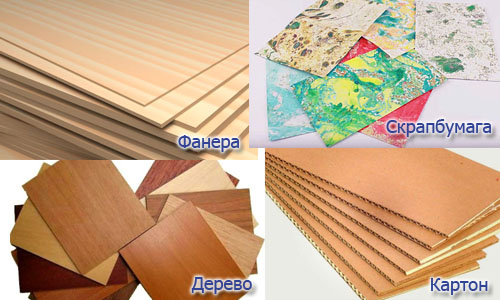
Comparative characteristics of materials:
| Material | Price | Durability | Complexity |
| Paper House | Very cheap | Low | Very easy |
| Cardboard house | Cheap | Not tall | Easy, but requires patience |
| House made of boxes | Very cheap | Not tall | Very easy |
| Plywood house | Moderately expensive | Tall | Medium difficulty, requires tool handling skills |
| Wooden house | More expensive than average, but cheaper than store-bought | Very high | Complex, cutting on professional equipment is desirable |
Drawings and dimensions of a paper house
The dimensions of the paper house are limited only by the size and density of the material used. Large models made from thin paper will not hold their shape. In the case where the material is dense but small in format, the house is assembled from individual parts.
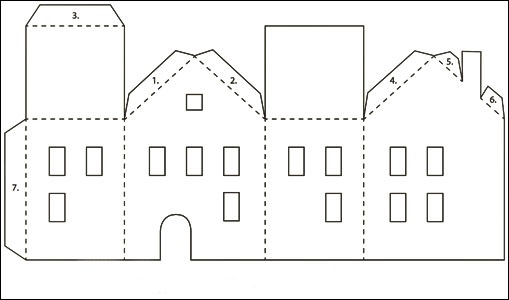
The peculiarity of the drawing of a paper house is that it is made up of a single piece.
At the joints of the walls, as well as on the roof slopes, additional narrow strips are provided for applying glue or double-sided tape. In the finished printouts, the houses are drawn in detail, they only need to be cut out and glued. Independent creation of the sketch leaves room for creativity and multi-layering when decorating.
Paper house option:
- 4 open rooms separated by two sheets of paper.
- The basic drawing consists of 2 rectangular parts with transverse cuts in the middle. The depth of the cuts is up to half the width of the elements.
- The dimensions of the blanks correspond to the height and double length of the future rooms.
Paper House for Dolls
To work you will need a drawing, scissors and glue.

With their help you need to:
- Carefully cut out the workpiece along the contour.
- Bend along the dotted lines to give the model volume.
- Apply glue to the special valves provided in the drawing.
- Glue the house together.
- Decorate with textured printed paper.
Such models do not imply interior decoration and act as decoration around which the game takes place.
The disadvantage of the model is that it can be conditionally called a dollhouse, since the whole structure is very schematic. But such a house has a play area. The child has the opportunity to create an interior in each room and freely move the doll inside. At the same time, the design takes up little space and is easily disassembled or folded for storage.
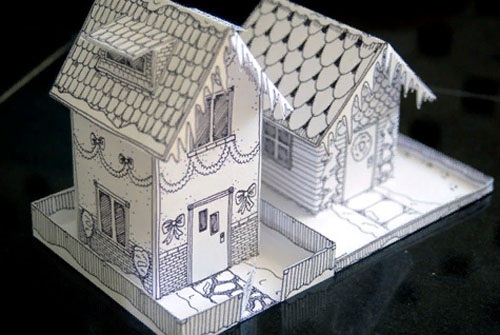
The work comes down to two actions:
- Cut out both pieces taking into account windows, doors and central slots.
- Connect the parts with cuts facing each other.
Next, you should decorate each room as you wish. Based on this drawing, more complex models can be created. For example, if you extend one of the elements and make 2 slots instead of 1, inserting one base piece into each of them, you will get a 6-room house.
Cardboard House Drawings
You can outline the details directly on the cardboard, but it is much more convenient to have the entire list of necessary elements, their quantity and sizes in front of you.
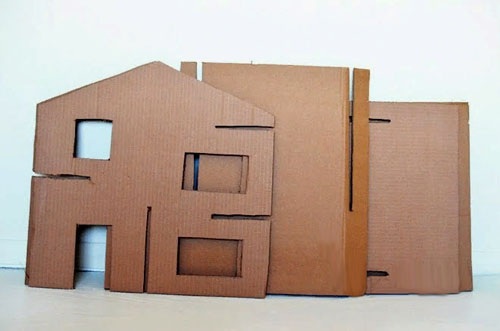
A schematic representation of the constituent parts of the house is sufficient, the main thing is to take them all into account:
- Side wall (2 pcs.): a rectangle whose height is equal to the topmost interfloor ceiling, and whose width is equal to the desired depth of the rooms.
- Back wall (1 pc.): a rectangle with a width equal to the length of the house and the same height as the side walls.
- Gable (2 pcs.): an isosceles right triangle whose hypotenuse is equal to the width of the side wall.
- Floor 1 (1 pc.): a rectangle with a height equal to the width of the side walls and a length equal to the width of the back wall.
- Interfloor overlap (1 pc.): a floor piece of the same dimensions, but with a cut-out stair opening.
- Interior partition (1 pc.): A U-shaped figure with a width equal to the depth of the house and a height corresponding to the height of one floor.
- Roof (1 pc.): a large rectangle, the height of which is slightly greater than the sum of the 2 legs of the pediment, and the length is slightly greater than the length of the house.
If you have a large piece of cardboard, the number of individual elements can be reduced., combining the side walls, gables, first floor floor and back wall into one piece on the drawing. Doorways will not be needed if the interior partitions are made one third narrower than the width of the house.
Connecting rooms
It is more convenient to connect the walls with wide masking tape. It does not damage the cardboard when removing, does not make the work sloppy and does not interfere with decorating. Moment Crystal glue will help to fix the cardboard walls relative to each other: it sets quickly and leaves no marks.
To connect walls together you should:
- Coat the cut of the side wall with glue and press it tightly against the edge of the back wall, trying to maintain a 90 degree angle.
- Cover the resulting corner with masking tape on the outside and inside, so that the middle of the adhesive tape falls on the joint of the walls.
- Similarly, attach the second side wall, forming a U-shaped frame for the future house.
- Coat the cut of the floor piece with glue on three sides, press it against the edges of the walls, while simultaneously adjusting the inner corners of the house.
- Each joint between the floor and the wall should be reinforced with adhesive tape on the outside and inside.
- Apply glue to the sections of the interior wall that will be attached to the floor and the back of the house.
- Press the part strictly perpendicular to the floor and parallel to the side walls of the house (check the distance between the walls at the bottom and top with a ruler, adjust if necessary).
- Cover the resulting corners on both sides of the partition with masking tape.
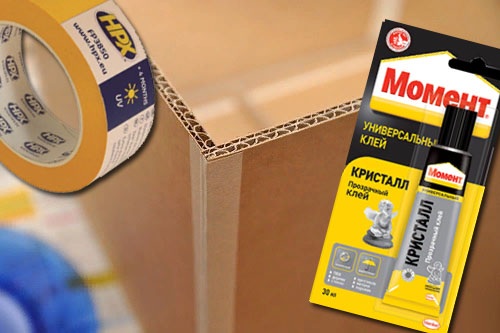
Pasting the corners on both sides will make the structure stronger, will fix the shape more rigidly. For a tighter fit of the tape to the surface, it is recommended to iron the gluing areas with force using the edge of a ruler or a plastic card.
Connecting ceilings to floors
The ceiling of one floor is the floor for the next. To prevent peeling and sagging, the interfloor ceiling is secured to a support.
- For accuracy, it is recommended to draw a line along the perimeter of the frame at the level of the upper boundaries of the internal walls parallel to the floor of the floor.
- Cut long strips of cardboard no more than 1 cm wide. If the material is not thick enough, you can cut twice as many strips and glue them together.
- Glue the resulting parts with the wide side along the perimeter of the house, aligning with the control line. You should get a uniform protrusion, encircling the outer walls from the inside.
- Apply glue to the edges of all the parts on which the ceiling will lie, as well as to the edges of the ceiling itself.
- Lay the ceiling piece, ensuring that the interior walls are perpendicular.
- Seal the joints between the walls and the floor of the upper floor with masking tape, making sure that the tape goes all the way to the corner without deforming it.
DIY Dollhouse from a Box
It is easier and faster to build a dollhouse from boxes with your own hands than from separate sheets of cardboard.
For work you will need the following materials and tools:
- cardboard box from large household appliances;
- marker;
- scissors, stationery knife;
- masking tape, glue;
- colored paper, ribbon, pieces of fabric - everything that can be useful in decorating the finished house.
Before starting work, you need to make sure that there are no defects on the cardboard, cut off excess tape and remove staples from the stapler.
- Use a marker to mark the middle of the box. It is convenient to use the line where the folding parts of the box join as a reference point.
- Cut along the line into 2 equal parts. One half will serve as the basis for the house.
- One of the folding parts will become the floor of the first floor. It should be fastened to the side walls of the box with tape.
- Cut off the corners of the opposite hinged lid to form the roof gable.
- At this stage, before additional volumetric parts are glued in, it is more convenient to cut out windows and doors. First, it is necessary to mark the future location of the interfloor ceilings with a marker. This will allow you to choose the correct location of the windows. It is more convenient to cut them out with a stationery knife. Cut the entrance door on one of the side walls of the house.
- Cut off both opening parts from the second half of the box. They will serve as ceilings for the second floor and the attic. Make an opening for the stairs in each part: cut off the left upper part in the shape of a small square or rectangle.
- Using tape, attach the floors along the previously marked lines. The openings for the stairs should be in opposite, internal corners of the house.
- Cut the roof slopes from the side walls of the remaining part of the box. Use tape to glue them to the gable and walls. Tape the top corner of the roof.
- Place cardboard ladders against the openings in the floor.
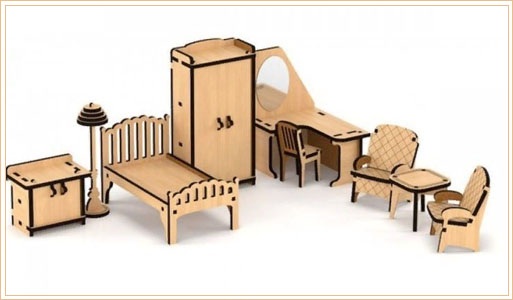
The construction of the dollhouse from the box is complete. It remains to decorate it and arrange the furniture.
Peculiarities of working with plywood
Dollhouses made of plywood are lightweight, environmentally friendly, and relatively inexpensive. But, unlike houses made from boxes, plywood ones are stronger, withstand heavy loads and last longer. When choosing this material, it is necessary to take into account the features of its processing.
- The tool for cutting the parts must be very sharp and selected in accordance with the thickness of the sheet: up to 1.5 mm - can be cut with a knife, 1.5-6 mm - with a hand jigsaw, over 6 mm - with an electric jigsaw.
- It is advisable to saw the sheet along the grain. In the case of a transverse direction, it is recommended to make several cuts along the entire length of the future cut, which will reduce the likelihood of cracks and chips.
- Finished parts should be carefully processed with sandpaper.
- It is better to connect the parts using wood glue. The connection will be stronger if the fibers of the glued surfaces have the same direction.
- For nails and screws, it is necessary to pre-drill holes and place washers under the heads.
Compliance with these rules will make the work easier and protect against unnecessary material consumption.
Necessary tools and materials
Anyone with basic tool skills, desire, and patience can make a dollhouse out of plywood.
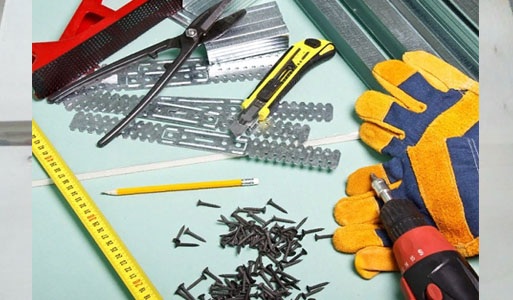
To build a house you will need the following tools and materials:
- plywood 6-7 mm thick;
- narrow wooden strip;
- small nails or a construction stapler;
- electric jigsaw (can be replaced with a hand saw);
- drill with a thin drill bit;
- sandpaper for processing the edges of parts;
- wood glue;
- mounting tape;
- a simple pencil and a tape measure;
- decor for the finished house.
The amount of material is calculated according to the drawing and depends on the size of the project.
For example, a small tabletop house will require 4-6 main parts, while a multi-story floor house can use 4-6 sheets of plywood. For accurate calculations, the finished sketch is disassembled into components, and a detailed drawing is made for each element.
After the parts are fully laid out on paper, the total area of the required material is calculated.
Drawings for a plywood house
A dollhouse made from boxes can serve as a model when creating a drawing yourself. A visual model, no matter how complex it is, will allow you to assess the scale of the idea, the actual dimensions of the product, identify the features of the main parts and possible weak points of the design.
Story about making a dollhouse from plywood:
For the simplest house with a pitched roof, you will need drawings of the basic elements.
- Side walls with an opening for the entrance door. The difference in the height of the walls will determine the angle of the roof.
- The back wall taking into account the pediment. The height differences on opposite sides must correspond to the side parts.
- Single-pitched roof.
- The base should extend beyond the house for better stability.
- Interfloor ceilings with stairwells, which are located in opposite corners so that they do not end up under the stairs leading to the floor above.
- Interior partitions with arched doorways.
Window openings are located on the rear wall, side elements and roof according to the sketch. If desired, you can add a front opening cover. In this case, it is more appropriate to place the windows on it. The dimensions of the parts depend on the available space where the house of individual wishes will stand.
The height of the floors should be comfortable for playing - 40-50 cm.
The topmost floor (attic or loft) is recommended to be installed no higher than the child's eye level. Rooms that are too deep are not convenient for playing, especially on the outer floors. A hidden attic box can be placed under the folding roof, where the dolls' outfits will be stored.
Step-by-step instructions for making a plywood house
A dollhouse made of boxes can be assembled in a couple of hours without a preliminary drawing, unlike a plywood one, where precision and accuracy are very important, which take time. Careful rechecking of all dimensions will facilitate the fitting and assembly of elements.
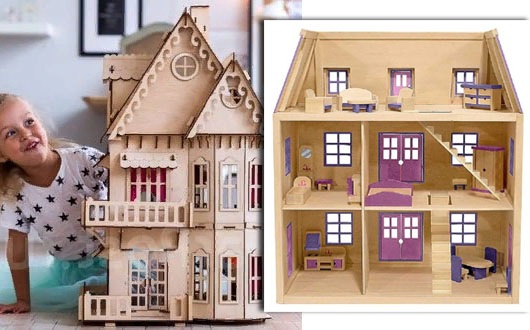
- Carefully and accurately transfer the image of the elements onto a sheet of plywood using a template and pencil.
- Using an electric jigsaw will allow you to cut parts faster and with better quality.
- To cut out window openings, make auxiliary holes with a narrow drill bit. Cut along the contour of the window and door.
- All cuts of each element must be sanded to avoid splinters and scratches.
- On the prepared parts, mark with a simple pencil the location of the interfloor ceilings and internal partitions.
- It is more convenient to start the assembly by gluing the outer walls, reinforcing the outer corners with mounting tape.
- Glue the internal elements according to the markings.
- Connect both blanks. For more reliable fastening of the floors, it is recommended to attach ceiling moldings made of slats or narrow strips of plywood along the perimeter of each room.
- Glue the roof slope to the gable and side walls.
- Glue the finished house to the base.
- All joints of the parts should be reinforced with mounting tape. Leave the house for a day to allow the glue to dry completely.
- For decorating the facade, one option is to use acrylic paint on wood.
- When decorating the interior, accessible materials that do not create heavy loads are selected: paper, fabrics, pieces of fur.
- To make the stairs, you will need rectangular pieces of plywood with a width equal to the openings prepared in the floors. The steps are made from cut narrow slats with a triangular cross-section, thin wooden blocks sawn diagonally, or strips of corrugated cardboard.
Stairs are installed after interior finishing work to avoid creating hard-to-reach areas.
Master class of a wooden house
A do-it-yourself dollhouse made from boxes or plywood has one significant drawback: fragility of the structure. Large models that combine the functions of a chest of drawers or a shelving unit require reliable fastenings and are made of wood.
When purchasing sheet material, it makes sense to immediately order cutting of parts.
This will reduce labor costs and compensate for the lack of expensive tools. The cutting line made on professional equipment is more accurate and even, which will significantly facilitate further processing of the wood. But even in this case, the process of making the house remains quite difficult for inexperienced craftsmen.
You can simplify the task by using old wooden furniture as a ready-made base.
To work, you need to prepare materials and tools according to the list:
- Wooden shelving unit.
- Wood putty.
- Plywood sheet 20-25 mm thick.
- Fiberboard sheet for interior partitions and the back wall of the house.
- Drill-driver, set of drills and screws.
- Wood glue, masking tape, liquid nails
- Sandpaper.
- Primer and white acrylic paint, universal orange and brown colorants, varnish.
- Materials for decoration.
- Scissors, pencil, ruler, tape measure.
- Thick cardboard.
- Brush and roller.
- A construction stapler or small nails and a hammer.
- Hand jigsaw.
The list may vary slightly depending on the condition of the furniture being remodeled and the choice of finish.
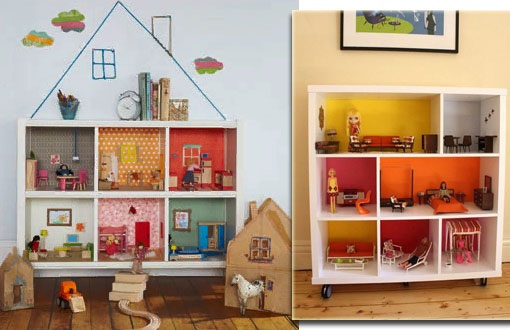
Additional materials are replaced with similar ones or those whose characteristics better correspond to the idea. Before starting work, the reworked piece of furniture must be freed from unnecessary parts: doors, drawers, guides and similar elements that will not be useful.
The entire subsequent process takes place in several stages:
- Making a simple dollhouse with your own hands begins with the stage of preparation and processing of the resulting wooden box. Clean the surface of the former rack well and process it with sandpaper to remove the old coating. Fill excess holes, chips, dents with wood putty. After the putty has completely dried, sand the surface.
- Mark windows on the side walls with a pencil. Cut out openings with a jigsaw, having first drilled auxiliary holes. Sand the edges until smooth.
- Cut out interior partitions with doorways from a sheet of fiberboard. Secure between the shelves using glue. For greater stability to the ceiling and floor, glue strips of thick cardboard, sandwiching a thin interior wall between them.
- Cut out 2 rectangles of the same width from thick plywood, equal to the depth of the rack, and different lengths, which depend on the length of the cabinet. For example, for a house 80 cm long, 55 cm and 60 cm pieces will be enough. The edges of the boards are pulled together with screws at a right angle. To do this, drill 3-4 holes at equal distances from each other along the short side of the long piece. Duplicate the holes at the end of the second piece. Apply wood glue to the joints and fasten both elements with screws. Sand the workpiece, paying special attention to the cut areas.
- Clean the parts of the house from dust and prime them. This measure promotes better adhesion of paint and glue to the surface and reduces their consumption.
- While the primer is drying, cut out rectangles of the same size from thick cardboard.. Paint the blanks with orange acrylic paint. Cover the dried rack with a layer of white acrylic paint from the outside and inside. Glue cardboard "bricks" to the side walls from the outside in a checkerboard pattern, leaving small gaps in the masonry for greater realism.
- Paint the roof dark brown and wait until the paint dries completely. Then install it on top of the house, adjust the position and fix it with screws. To do this, drill 3-4 through holes in the direction perpendicular to the roof slopes through the inner joint of the side walls and the ceiling and screw in the screws.
- Cover the entire surface of the house with matte varnish. Dry well.
- Cut out the back wall from the fiberboard. Secure it along the outline of the house with a construction stapler or small nails.
- Decorate the interior, arrange toy furniture.
A dollhouse made from boxes is much quicker and easier to make. But even a wooden model is within the power of an ordinary person, if you take a fresh look at old things.
Features of finishing a dollhouse
Interior decor depends entirely on individual preferences. When choosing materials and finishing methods, advice and ideas from experienced craftsmen will not be superfluous.
Recommendations:
- The paint must match the surface being painted: For cardboard, gouache is chosen, and for wood, safe acrylic paints.
- For fragile houses, the decor is chosen to be light and not overload the structure.
- The presence of a pull-out drawer in the podium or a blind attic with a lid in wooden houses will allow you to store additional interior items or doll outfits in one place.
- Scrapbooking paper is universal in dollhouse decoration: it is thick, does not fade, has a huge variety of designs and textures. A small pattern will look more realistic as wallpaper, a “wooden” print will add realism to the facade or floor.
- Hand-made toy furniture will highlight the uniqueness of your dollhouse. You can make a beautiful chair from a plastic shot glass. The fireplace is easy to assemble from matchboxes. Two cardboard blanks and a mat will make a bench.
- Textiles will add coziness and texture to the interior. It is more convenient to attach curtains to the house from a box using hot glue. Velvet or velour will imitate carpeting.
- Instead of stairs, you can make an elevator cabin, which the child can raise and lower using a chain.
This is only a small part of what can be implemented in the interior of the house. Using interesting techniques, such as decoupage, makes the decor possibilities limitless.
Window and door decoration
Windows and doors are designed in accordance with the main material of the structure. The stronger the model, the more complex the door fastenings and the more detailed the decor.
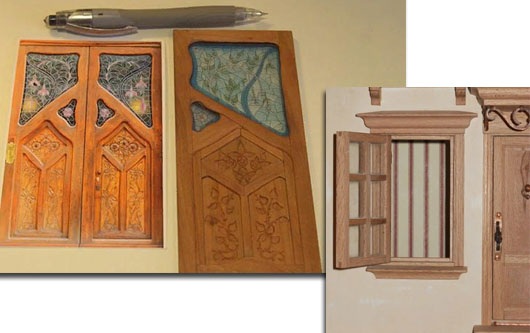
- In paper houses, windows and doors are drawn. The entrance door is cut out on three sides. Windows are cut out according to the picture: as sashes or as a complete opening. It is not advisable to cut out openwork lattices and lintels - thin parts will quickly tear during the game, giving the house a sloppy look.
- In houses made of corrugated cardboard, the door is cut out in a similar way. If the model is assembled from beer or bookbinding cardboard, then the door part is cut out completely. For fastening, you will need a small piece of gauze or bandage, strong paper and glue. Insert the door into the opening and coat it with glue, capturing the part of the wall to which it will be attached. Put a piece of gauze on top and apply a thin layer of glue again. Cut a rectangle out of paper equal to the door and glue it on top of the gauze, connecting the door leaf to the wall. The gauze will add strength to the fastening, and the paper will prevent sagging. For decoration, stick an image of a real door onto the piece. Cut 2 frames out of cardboard and cover the doorway with them on both sides. The window openings are decorated in the same way.
- In wooden houses, doors are attached with piano hinges. The doorway is decorated in the same way as in the previous case. The decor can be complicated by imitation brickwork, the presence of a door knocker or a bell. Window openings can be decorated from the outside with "glass" made of transparent plastic. Decorate the top with a wooden photo frame. Make a cardboard frame from the inside. Using stained glass paints on a plastic window will make the facade bright and unusual.
- Interior doors are usually not installed. An arched opening or installation of a narrower wall is sufficient.
The image is created by details: even the simplest house will become brighter and more interesting if you pay attention to the windows and doors.
How to make a roof
If possible, for self-production it is recommended to choose simpler roofing forms with simple fastening.
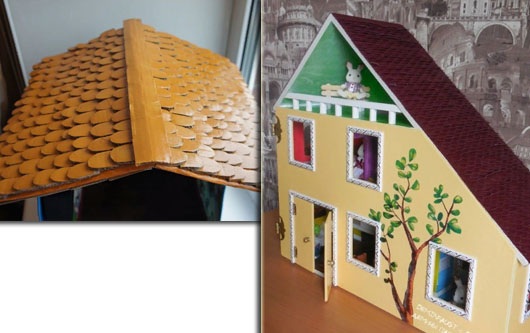
- For a paper house, the roof is cut out and glued according to the diagram.
- In cardboard models with a gable roof, it is better to place the gables at the ends. Then the roof will have a reliable support. To make it, you will need a large piece of soft corrugated cardboard. To calculate the dimensions, you need to measure the length of the house and the length of the gable slopes. The roof should have small allowances on each side, like real roofs. Almost the entire middle is cut out from the front part for an accessible view of the upper floor. The cuts of the gable and the back wall are coated with glue. The roof part is placed on top and lightly pressed for better gluing.
- In wooden houses, single-pitched roofs are popular, which rest on one side wall and descend to the second, shorter one. The back wall also serves as a support. Such a roof is attached with glue or small nails.
- For a gable roof on the top floor, an interior partition is provided, which serves as an additional support. In cases where it is impossible to install a partition, the slopes are additionally connected from the inside with a lintel in the upper part of the roof. This method is convenient for roofs made of cardboard. Heavier materials are more reliably reinforced with small-section wooden beams, which are assembled in the shape of a triangle and, like a gable, support the roof at the front of the house, leaving access to the attic. The ridge of a gable roof is glued or tightened with screws.
When choosing materials for a dollhouse, you can use a short table with comparative characteristics. The comparison is very conditional, since with rich experience you can create a complex model from a box, which not everyone can repeat. And you can make a budget wooden house with your own hands from an old chest of drawers.
Author: Mamina Anastasia
Article formatting: E. Chaikina
Useful video about DIY dollhouse
Video on making a paper dollhouse:

Someone is lucky to have such a dad! And we only made a house out of paper, for a paper doll... I don't know how to saw boards (